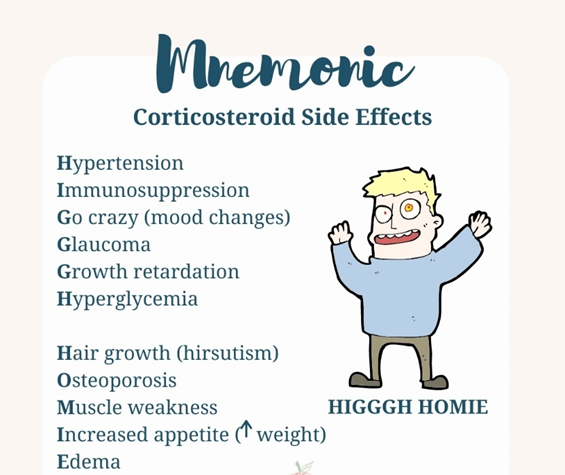A nurse is planning care for a client who has multiple sclerosis and is receiving methylprednisolone. Which of the following adverse effects should the nurse anticipate? (Select all that apply.)
Bladder spasms
Hypotension
Delayed wound healing
Hirsutism
Hyperglycemia
Correct Answer : C,D,E
Choice A Reason:
Bladder spasms are not commonly reported as adverse effects of methylprednisolone. However, bladder dysfunction can occur in individuals with multiple sclerosis due to the disease process itself, but it is not specifically related to corticosteroid therapy.
Choice B Reason:
Hypotension is not a common adverse effect of methylprednisolone. In fact, corticosteroids can often lead to fluid retention and sodium retention, which can contribute to hypertension rather than hypotension.
Choice C Reason:
Delayed wound healing is correct. Corticosteroids can impair the body's ability to heal wounds by suppressing the inflammatory response and collagen synthesis. Therefore, clients receiving methylprednisolone may experience delayed wound healing, which can be problematic, especially in individuals with pre-existing wounds or undergoing surgical procedures.
Choice D Reason:
Hirsutism (excessive hair growth, especially in women) can occur with long-term corticosteroid use due to the effect of steroids on hair follicles. It is a possible adverse effect of methylprednisolone.
Choice E Reason:
Hyperglycemia is correct. Corticosteroids can increase blood glucose levels by promoting gluconeogenesis, reducing glucose uptake by tissues, and inducing insulin resistance. Clients receiving methylprednisolone may develop hyperglycemia, which can be particularly concerning for individuals with diabetes or those at risk of developing diabetes.

Nursing Test Bank
Naxlex Comprehensive Predictor Exams
Related Questions
Correct Answer is B
Explanation
Choice A Reason:
Pregabalin is incorrect. Pregabalin is a medication used to treat neuropathic pain, seizures, and generalized anxiety disorder. It is not associated with an increased risk of PML.
Choice B Reason:
Natalizumab is correct.: Natalizumab is a monoclonal antibody used to treat relapsing forms of MS. It is associated with an increased risk of developing PML, particularly in individuals who are JC virus antibody positive. Regular monitoring of JC virus antibody status and clinical vigilance is required when using natalizumab to reduce the risk of PML.
Choice C Reason:
Furosemide: Furosemide is a loop diuretic used to treat edema and hypertension. It is not associated with an increased risk of PML.
Choice D Reason:
Metoprolol is incorrect .Metoprolol is a beta-blocker used to treat hypertension, angina, and heart failure. It is not associated with an increased risk of PML.
Correct Answer is D
Explanation
Choice A Reason:
Hypoxemia due to dead space is not appropriate. Dead space refers to areas of the lung where ventilation occurs but no perfusion takes place. In ARDS, hypoxemia typically occurs due to ventilation-perfusion (V/Q) mismatch and shunting rather than dead space.
Choice B Reason:
Impaired carbon dioxide elimination due to shunting is not appropriate. Shunting occurs when blood bypasses ventilated alveoli, leading to inadequate gas exchange. In ARDS, shunting contributes to hypoxemia, but it doesn't directly impair carbon dioxide elimination.
Choice C Reason:
Decreased pulmonary arterial pressure due to ventilation-perfusion (V/Q) mismatch is incorrect. V/Q mismatch occurs when ventilation and perfusion are mismatched in different areas of the lung. This leads to areas of low ventilation (dead space) and areas of low perfusion (shunting). V/Q mismatch contributes to hypoxemia in ARDS but does not typically lead to decreased pulmonary arterial pressure.
Choice D Reason:
Decreased pulmonary compliance due to stiffness is correct. This is a characteristic feature of ARDS. The inflammation and damage to the alveoli cause them to become stiff, reducing pulmonary compliance and impairing lung expansion during ventilation.
Whether you are a student looking to ace your exams or a practicing nurse seeking to enhance your expertise , our nursing education contents will empower you with the confidence and competence to make a difference in the lives of patients and become a respected leader in the healthcare field.
Visit Naxlex, invest in your future and unlock endless possibilities with our unparalleled nursing education contents today
Report Wrong Answer on the Current Question
Do you disagree with the answer? If yes, what is your expected answer? Explain.
Kindly be descriptive with the issue you are facing.
